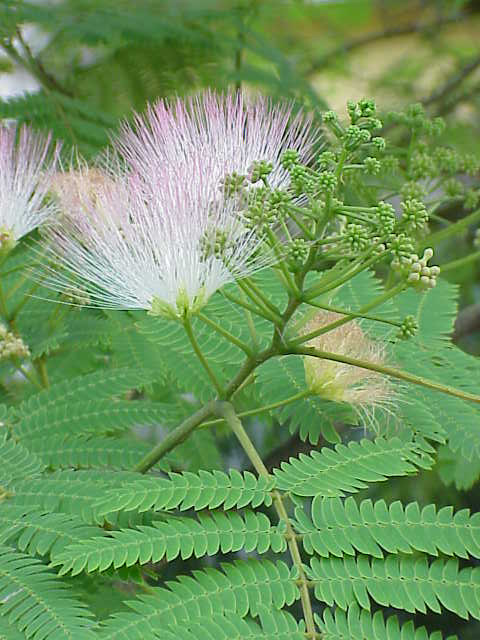- Albizia
__NOTOC__Taxobox
name = "Albizia"

image_width = 200px
image_caption =Persian Silk Tree ("Albizia julibrissin"), foliage and blossoms
regnum =Plant ae
divisio =Magnoliophyta
classis =Magnoliopsida
subclassis =Rosidae
unranked_ordo =Eurosids I
ordo =Fabales
familia =Fabaceae
subfamilia =Mimosoideae
tribus =Ingeae
genus = "Albizia"
genus_authority = Durazz., 1772
diversity = About 150 species, seeList of Albizia species
diversity_link = List of Albizia species
synonyms ="Albizzia"Benth. "Albizia" is a
genus of about 150species of mostly fast-growingsubtropical andtropical tree s andshrub s in the SubfamilyMimosoideae of thelegume family, Fabaceae. The genus is pantropical, occurring inAsia ,Africa ,Madagascar , Central, South, and southernNorth America andAustralia , but mostly in the Old World tropics.They are commonly called silk trees or sirises. Peculiarly, the obsolete form of spelling the
scientific name - with double 'z' - has stuck, so that another commonly used term is albizzias (though the form albizias is also found, particularly in species that are not widely known under a common name). Thescientific name refers to the Italian nobleman Filippo degli Albizzi, who in the mid-18th century introduced siris toEurope .These are usually small trees or shrubs with a short lifespan - though the famous "Samán del Guère" near
Maracay inVenezuela is a huge "Albizia saman" specimen and several hundred years old. The leaves are pinnately or bipinnately compound. Their smallflower s are in bundles, with showy stamens much longer than the petals. Some species are consideredweed s.Persian Silk Tree or Pink Siris ("Albizia julibrissin") extends well north into temperate regions inEast Asia and is by far the cold-hardiest species. It tolerates temperatures down to about -22°F (-30°C), provided it gets adequate summer heat to ripen the shoots. InNorth America , where it is commonly grown as anornamental tree , it is often confusingly called "mimosa", a name which correctly belongs to species in the related genus "Mimosa ". In several US States, "A. julibrissin" has become naturalized and is regarded as aninvasive species ."Albizia" species are used as food plants by the
larva e of somemoth s of the genus "Endoclita " inclulding "E. damor", "E. malabaricus" and "E. sericeus".Taxonomy
Numerous species placed in "Albizia" by early authors were eventually moved to other genera, most notably "
Archidendron ". Other genera ofIngeae ("Abarema ", "Archidendropsis ", "Balizia ", "Blanchetiodendron ", "Calliandra ", "Cathormion ", "Enterolobium ", "Havardia ", "Hesperalbizia ", "Hydrochorea ", "Pararchidendron ", "Paraserianthes ", "Pseudosamanea " and "Serianthes ") have also received their share of supposed "Albizia" species, as have theMimoseae "Newtonia" and "Schleinitzia ", and "Acacia "Verify source|date=March 2008 from theAcacieae . Some presumed "silk trees" are in fact misidentified members of the not very closely related "Erythrophleum " from theCaesalpinioideae and theFaboideae "Lebeckia ".ILDIS (2005)]The delimitation of "
Falcataria " and "Pithecellobium ", close relatives of "Albizia", is notoriously complex, with species having been moved between the genera time and again, and probably will continue to do so. These include for example "Falcataria moluccana " (Moluccan Albizia , formerly "Albizia moluccana "), a common shade tree ontea plantations. Other closely-related genera like "Chloroleucon " and "Samanea " are often merged with "Albizia" entirely.Gallery of "
Albizia procera "ee also
*
List of Albizia species Footnotes
References
* (2005): [http://www.ildis.org/ Genus "Albizia"] . Version 10.01, November 2005. Retrieved 2008-MAR-30.
Wikimedia Foundation. 2010.
